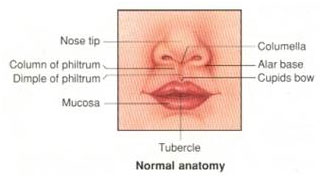16 Nov What is Cleft Lip & Palate

A Cleft Lip (CL) is a separation in the upper lip. A Cleft Palate (CP) is an opening in the roof of the mouth. Clefts result from incomplete development of the lip and / or palate in the early weeks of pregnancy. During this time the face is being formed – the top and the two sides develop at the same time and grow towards each other, finally fusing in the middle. The lip and primary palate develop at 4 to 6 weeks of gestation. While the secondary palate develops at approximately nine weeks.
In the instance of a cleft forming, the final closing does not fuse properly and an opening remains. The cause or causes for this failure to close are as yet not clearly understood, although research has been and continues to be undertaken. Genetics and environmental factors are both considered instrumental in causing clefts.
A sub mucous cleft palate is where, although the surface layers of the soft palate (mucous membrane) are complete. The underlying muscle is incomplete. A submucous cleft of the hard palate is where the bony element is incomplete. In its most minor form, only the uvula is cleft, but even this leads to an abnormality in the muscles in the palate and, if the speech is affected, a repair will be required. Normal speech production is the primary goal of any surgical repair of a sub mucous cleft. A sub mucous cleft palate can prove difficult to identify, the palate appearing normal in some children. Special tests may be necessary to properly identify it.
A cleft lip or cleft palate can be either unilateral (one side only) or bilateral (both sides). A cleft can be either complete or incomplete. A complete palatal cleft involves both the primary and secondary palate, while an incomplete cleft involves the secondary palate only. A child may be born with either a cleft lip or cleft palate or both. Combined cleft lip and palate represents approximately 50% of incidents, cleft palate only alone 30%, and cleft alone 20%.

